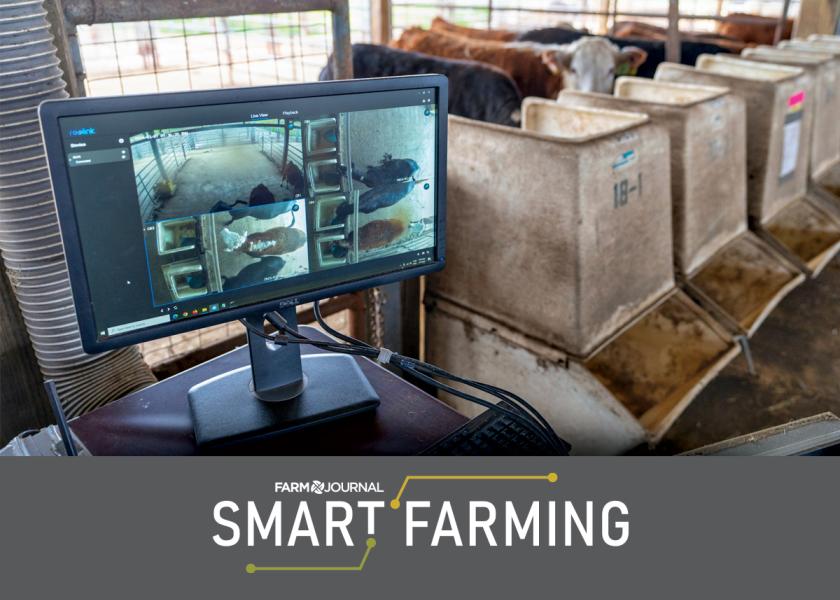A ‘Smart’ Examination to Improve Livestock Management Efficiency

A Texas A&M AgriLife animal nutritionist believes precision livestock management — utilizing an extra set of eyes and ears and a little artificial intelligence — can go a long way toward making today’s livestock operations more efficient.
Luis Tedeschi, Ph.D., Texas A&M AgriLife Research Fellow and Chancellor EDGES Fellow in the Texas A&M College of Agriculture and Life Sciences Department of Animal Science, is looking for cost-effective and noninvasive methods of monitoring feeding behaviors in livestock operations that producers can adapt to improve their bottom line – all through alerts on a cell phone or computer.
Texas has about 3 million cattle in feedlots and another 10 million cows, heifers, steers, bulls and calves in different feeding situations annually.
Tedeschi said if the managers of these livestock use modern technological advances or “smart” practices, then the industry can better understand what is happening at the feed bunk and in the pens to make management decisions accordingly.
Research goals to harness precision livestock farming
Over the next three years, he will create and utilize a precision livestock farming facility at Texas A&M to determine where some of the most significant changes can be made. His research is funded by a U.S. Department of Agriculture National Institute of Food and Agriculture grant: Harnessing Precision Livestock Farming to Support Smart Agriculture for Sustainable Beef Cattle Production.
Tedeschi said his goals with this project are to:
- Make artificial intelligence an invaluable and accessible tool for producers.
- Make production sustainable from an economic, social and environmental perspective.
- Ensure the producers are on top of the cutting-edge and innovative advancements they can utilize to improve their production.
- Deliver services leveraging cutting-edge research, sophisticated data analysis and artificial intelligence within a precision livestock farming data framework. This could create opportunities for others to use the technology and create their own business to assist producers.
The project falls under the Research Facilities Act Program approved by Congress in 2023 and will include modifications at the department’s Animal Nutritional and Physiology Center. For the next three years, the team will collect data after setting up all the equipment and measuring the system’s precision and accuracy.
The Texas A&M AgriLife team from the Department of Animal Science includes Tedeschi, his doctoral student Egleu Mendes; Karun Kaniyamattam, Ph.D., an AgriLife Research quantitative animal performance scientist and assistant professor; and Gordon Carstens, Ph.D., an animal nutrition professor. They are teaming up with the Texas A&M Institute of Data Science, which includes Nick Duffield, director; Jian Tao, assistant director for project development; and Yalong Pi, an associate research scientist.
Can technology help pen riders?
Feed efficiency is a prerequisite to achieving sustainable livestock intensification, Tedeschi said.
“Precision livestock farming is all about getting to know your animals, their needs and what value you can give them,” Tedeschi said. “We strive to match the animal’s needs to the level of management we are providing and then align that with the kind of performance we are expecting from that animal.”

The project’s ultimate goal is to integrate data streams related to precision feeding and health monitoring sensors into existing and newly developed decision models to implement real-time management decisions for the livestock feeding industry.
Using sensors, cameras and microphones, the team will collect information about a pen of cattle, such as what percent of the time they are walking, eating, playing, grooming, lying down or getting water. Knowing their behavior can help calculate how much feed they eat and at what time of day.
“Once I know what they are doing, I can calculate a more accurate prediction of how much energy those animals need or how much they are expending,” Tedeschi said. “I know that if an animal eats too fast and only once per day, that animal will have digestive problems, and management may require judicious use of antibiotics.”
Combining recorded sounds with artificial intelligence can help identify the difference between a cough and a clearing of the throat by a single animal, allowing for early identification of respiratory issues. The cameras can also help identify lameness, bloat and disease or even alert the owner if wildlife is causing issues in the pens.
“We can even collect enough information on the animal to determine when it is ready to go to market,” Tedeschi said. “You can determine how many animals in a particular pen are ready to go and when to sell them for the maximum profit. Is that when 70% of a pen is ready or 82% ready? It allows the owner to look at the market to determine when it is most profitable.”
Capitalizing on technology to create sustainability
Tedeschi said the project will allow them to show producers what and how to apply precision livestock farming, what benefits they can obtain, and how to do it.
He envisions a new subscription program could be created for use by any producer to get sensors installed. Then a data science center could accept the information, process it using artificial intelligence modeling, and send critical information back to the producer to assist their decision-making process. This would allow small operators who don’t really have the opportunity to invest in extensive technology to also improve their efficiency and be more sustainable.
“This research allows us to keep improving the sustainability of beef cattle operations in Texas,” Tedeschi said. “The big idea is to provide the information to everyone – we don’t control anything, just provide educational recommendations. We can train people to analyze the data. We can identify issues that happen in different regions or under different market conditions.
“But first, we need to show the livestock producers the possibilities and the opportunities.”







